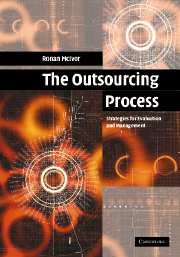Book contents
- Frontmatter
- Contents
- List of figures
- List of tables
- List of illustrations
- Acknowledgements
- 1 Introduction
- 2 The trend towards outsourcing
- 3 Theoretical influences on outsourcing
- 4 The outsourcing process: a framework for evaluation and management
- 5 Determining the current boundary of the organisation
- 6 Activity importance analysis
- 7 Capability analysis
- 8 An analysis of the strategic sourcing options
- 9 Developing the relationship strategy
- 10 Establish, manage and evaluate the relationship
- 11 Case study – outsourcing experiences at Telco
- 12 Conclusions
- Index
- References
6 - Activity importance analysis
Published online by Cambridge University Press: 21 August 2009
- Frontmatter
- Contents
- List of figures
- List of tables
- List of illustrations
- Acknowledgements
- 1 Introduction
- 2 The trend towards outsourcing
- 3 Theoretical influences on outsourcing
- 4 The outsourcing process: a framework for evaluation and management
- 5 Determining the current boundary of the organisation
- 6 Activity importance analysis
- 7 Capability analysis
- 8 An analysis of the strategic sourcing options
- 9 Developing the relationship strategy
- 10 Establish, manage and evaluate the relationship
- 11 Case study – outsourcing experiences at Telco
- 12 Conclusions
- Index
- References
Summary
Introduction
This stage in outsourcing evaluation involves determining the level of importance of the activities that have to be performed in order to satisfy customer needs. It is crucial for an organisation to determine which activities are critical to competitive advantage. Identifying critical activities involves understanding the major determinants of competitive advantage in the markets or the industries in which the organisation competes or might wish to compete. An analysis of the competitive environment and customer needs can have an important role in identifying which activities are critical for success in the business environment. Critical activities will enable an organisation to differentiate itself from its competitors in the way in which it serves its customers. An understanding of critical activities is central to outsourcing evaluation. For example, if an organisation possesses a superior capability in a critical activity relative to competitors or suppliers, then it should continue to perform that activity internally. The organisation must also have a clear understanding of how sustainable this position is over time. Alternatively, where possible, activities that are not key influences on the ability of the organisation to achieve competitive advantage should be outsourced. Critical activities are those that can be used to build sources of advantage that are difficult and costly for competitors to replicate. Focusing attention on customer needs and competitive advantage will involve the organisation applying its distinctive capabilities to meet the needs identified.
- Type
- Chapter
- Information
- The Outsourcing ProcessStrategies for Evaluation and Management, pp. 115 - 145Publisher: Cambridge University PressPrint publication year: 2005

